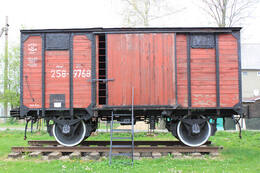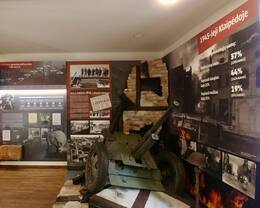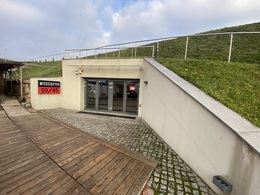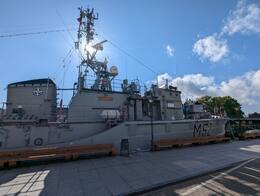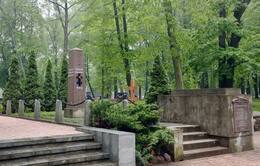Legacy of the Cold War and Soviet Occupation in Žemaitija
Day 1.
52 km
Klaipeda – Priekule – Klaipeda
Practical info
- The itinerary is intended as a guide - how to optimally travel a region or country, or two countries, with the aim of getting to know their military heritage;
- The driver must plan for himself - how many of the recommended objects and places he can explore in one day;
- Before traveling, you should check the opening hours of sightseeing places (museums, collections, fortifications, etc.);
- For places where advance booking is required (local guides, private collections, etc.), a visit must be booked, specifying the date and time. If the trip is cancelled, the places booked must be informed;
- Accommodation must be booked in advance. Accommodation may be unavailable during the summer season, especially on the coast. Some catering establishments may not be open during the winter season;
- Choose not only summer for your trip, but also other seasons;
- The Latvian-Lithuanian-Estonian borders can be crossed by road freely without restrictions and at any time of the day. When entering from one country to another, you must have an ID card or passport with you;
- Visit tourist information centers where you can get additional information, brochures, and maps.
Sights
Museum of the History of Freedom Fights and Exile in Priekulė
In Priekulė, on Klaipėdos Street (there is a directional sign).
The museum is located in the buildings of the former East Prussian gendarmerie station. They were built in 1909 according to a typical project. After the war, the buildings were occupied by Soviet repressive structures: in 1945–1950, the NKVD-MVD-MGB Priekulė parish subdivision operated here, in 1950–1953, the MGB Priekulė district department, and in 1946–1953, the Priekulė riot police headquarters were also located here. People were interrogated and tortured in the main building of the former station and its basement, detainees were imprisoned in the former farm building, and the bodies of the murdered were dumped in another building. The bodies were later buried in the garden deep in the plot or taken out and dumped in a peat bog in Drukiai.
The museum opened its doors in these premises in 2006. The main themes of the exposition are the post-war resistance struggle and deportations in this Klaipėda region. The museum also has an outdoor exposition: a deportation wagon and a replica of a partisan bunker are on display. Signs of memory have been created on the museum territory: a chapel has been installed, chapel pillars created by folk artists stand, and a memorial has been built on the site of a mass grave.
Exposition “Sovietmečio pėdsakais” (“In the Footsteps of the Soviet Era”) at the History Museum of Lithuania Minor
The exposition is located in the central part of Klaipėda. When the Soviets occupied Lithuania in 1940, Klaipėda and the region of Klaipėda were already part of the German Reich. In January 1945, Klaipėda was captured by the Red Army. According to the registration data of the war commandant, only 28 civilians were left in the town at the time. The new Soviet period in Klaipėda began. One repressive regime was replaced with another.
The exposition “Sovietmečio pėdsakais” (“In the Footsteps of the Soviet Era”) aims to reflect the Soviet era and the changes that began in the late 1990s and to help understand the complex Soviet atmosphere. The exposition tells the story of the new inhabitants, the construction of the “socialist” Klaipėda, the Soviet ideology and propaganda efforts, the desire to destroy everything that was national, folk and civic, as well as religious consciousness. Different stories and themes are revealed: the interior of a Soviet-era living room of an intelligent person illustrates the everyday life of people of that time; an improvised “red corner” and the Soviet slogans reflect the methods and banality of Soviet propaganda; a computer terminal demonstrates the construction of Blessed Virgin Mary, Queen of Peace Church in Klaipėda and its fate in 1957–1963, etc.
World War II Exposition “Muziejus 39/45”
“Muziejus 39/45”, which belongs to the History Museum of Lithuania Minor, tells the story of the Second World War events in Klaipėda and the region. The museum is located under a rampart on the eastern side of the former Klaipėda Castle, where German troops had set up an explosives depot during the war.
The exposition of the museum is modern and engaging for visitors: the exposition consists of four halls that present different periods of the wartime, and 13 interactive points have been installed in the halls. The hall “Klaipėda on the Eve of War” displays historical documents and photos, while the radical changes in Europe of the time are described on an original animated map. The hall “The Storming of Klaipėda” reflects the very tragic history of Klaipėda and its inhabitants, while the second hall “Klaipėda after the War” features an installation commemorating the demolished churches of the city. The last one – the Hall of Memories – features a symbolic six-metre-long carriage with a glass roof, under which multiple simple household objects that once belonged to both German soldiers and Klaipėda civilians are on display. The glass is coated with a layer of sand, so you have to brush the sand off with your fingers to see the exhibits.
Mine countermeasures ship-museum M52 "Sūduvis"
The M52 “Sūduvis” mine countermeasures ship-museum is located on the Karališkoji Danės waterfront of Klaipėda, next to Castle Bridge.
It is a “Lindau” mine trawler class ship, built in 1956–1958 in West Germany. The mission of these ships is to detect and destroy sea mines. The hull was therefore made of Brazilian oak, the deck of teak, and the machinery, of non-magnetic metal.
From 1958 to 1999, the ship belonged to the German Navy and was named M1071 “Koblenz”. From 1978–1979, it was converted from a mine trawler to a mine hunter.
In 1999, the ship was transferred to the Lithuanian Navy. Navy ships are traditionally named after historical regions of Lithuania, so the received ship was also named M52 “Sūduvis”. The ship served Lithuania for 22 years, taking part in international and national exercises and operations. In 2021, the ship left the service of the Lithuanian Navy and was handed over to the Lithuanian Maritime Museum. Then, 52 “Sūduvis” was opened to the public and adapted for the needs of museum and educational use. The vessel on display has authentic operational equipment.
Sculpture Park in Klaipėda
The park is located in Klaipėda between K. Donelaičio, Liepų, Trilapio and S. Daukanto streets.
Sculpture Park in Klaipėda is a multi-layered witness to the history of the city and of the world. A cemetery, a park, a memorial, a place for art – all this and more can be accommodated in one area.
In 1944–1945, the Soviet occupiers regained their positions in ithuania, but Klaipėda was left without its old inhabitants. The once new, now old, city cemetery was left neglected. Finally, in 1977, it was disposed of, a Sculpture Park was built instead, and the installation of artworks began.
Today, the park is known as an open-air sculpture gallery of Lithuania’s mature modernism. 116 works created during the Soviet period (1977–1989) are on display here. Alongside works of art and relics of the ancient cemetery, monuments are also displayed here:
• Memorial to the events of the 1923 Klaipėda Uprising (1925);
• Memorial to the Soviet soldiers of World War II (1949–1980), part
of which was dismantled in 2022 after the outbreak of the war
of Russia against Ukraine;
• a memorial stone to the old inhabitants of Klaipėda – the
Memelenders (1992).
French prisoners of the Franco-Prussian War, German Imperial soldiers of the First World War, soldiers of Independent Lithuania, Belgian, Polish and French prisoners of the Second World War are also honoured with commemorative signs.




